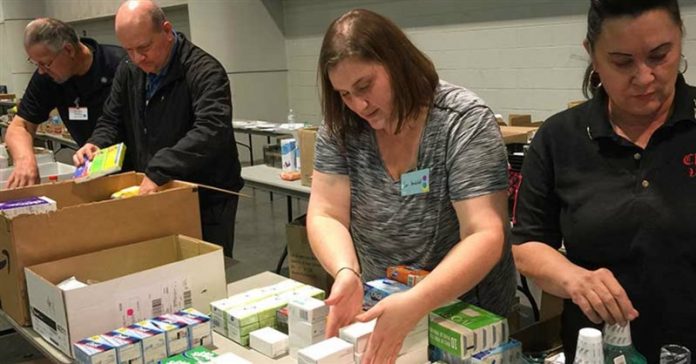[ad_1]
Little about Brian Scroggins’ role overseeing crisis preparedness for dozens of southern Nevada’s churches prepared him for the most deadly mass shooting in U.S. history.
Yet the morning after Stephen Paddock fired at concertgoers from the 32nd floor of the Mandalay Bay hotel on the Las Vegas Strip, killing 58 and wounding almost 500, Scroggins’ phone rang with a question:
Would he help establish a family crisis response center, and would he be responsible for the spiritual and religious needs of the victims and their families?
For almost two weeks now, Scroggins has spent upward of 12 hours a day walking the Las Vegas Convention Center’s gray halls and cavernous rooms — a stark contrast to the flashing neon rainbow just a few blocks away. He has hugged the anxious, prayed with the distressed, cried with the mourning. He has coordinated donations of food and clothing, kept track of what victims are in which hospitals and organized the services of chaplains and grief counselors.
But if Scroggins couldn’t rely on his disaster training, he could turn to his religious experience. Scroggins, 54, is a lifelong member of the Church of Jesus Christ of Latter-day Saints — or Mormons — which emphasizes preparedness for its 15 million adherents.
“I believe Heavenly Father wanted me to be here,” he said during a rare break in his duties about a week after the shooting. His voice broke and his eyes watered.
“I believe he inspired me so that when I was called, I was prepared. I believe he knew I was going to need this training.”
Scroggins was raised far from Las Vegas, in Birmingham, Ala., one of only three Mormon students at his high school. His grandparents were baptized into the LDS church in the 1920s, but it wasn’t until he went to Brigham Young University-Idaho that he attended an LDS worship service.
Like most LDS young men, he served a two-year mission, assigned to San Bernardino, Calif. — the site of another mass shooting in 2015. He got married and moved to Las Vegas in 1988, and went to work for a hotel, a newspaper, a public utility and a homebuilder. Eventually, he and his wife opened a signage business, and now he works as deputy director of Nevada’s charter school authority.
It was while he was employed by the water utility that he began working on disaster preparedness. He took Federal Emergency Management Agency classes and went on to a master’s degree in emergency management.
Along the way, he became a “welfare specialist” for his local Mormon ward, or church, and then for a number of wards. A welfare specialist is a kind of point man in charge of ensuring other Mormons are ready for hardship — the loss of a job, the onset of a natural disaster — by putting aside money and at least a three-month supply of food and water.
A welfare specialist also helps church members advance their education, their job skills and their spiritual strength, with the goal of self-reliance — helping themselves and helping others, in the language of the church.
“During His mortal ministry, the Savior walked among the poor, the sick, and the distressed, ministering to their needs and blessing them with healing and hope,” the church says in “Providing in the Lord’s Way,” a leader’s guide to welfare. “He taught His disciples to do the same. Reaching out to those in distress is a central characteristic of the disciples of Jesus Christ.”
But the guide says nothing about how to minister to those devastated by violence or terrorism, which both rent the usual festive air of the Las Vegas Strip on Oct. 1.
Still, when the call came the next morning from the city’s office of emergency management, Scroggins said he did not hesitate. He headed to the convention center and found himself swept up.
“People were here already,” he said. “I sat with them and I cried with them and I made sure they had whatever we could do to comfort them.”
Bill Tsagrinos is the bishop of Scroggins’ ward and has known him at least a decade.
“We believe we are put here to serve God by serving other people,” Tsagrinos said. “That is what Brian does, he just gives selflessly to others.”
The work has been rewarding and overwhelming. The sister of one victim was also a member of the LDS church in another state, and Scroggins prayed with her. Then he found himself with another man, whose fiancee was shot and died in his arms.
“I shed many tears on Monday and I am OK with that,” he said. “We are here for compassion and love to share the light of Christ with those who need it.”
He has coordinated chaplains, ministers and grief counselors, including those from a Buddhist relief society, a local evangelical ministry and a rabbi who arrived from Los Angeles in an RV. Volunteers who just show up are put to work, too.
“I didn’t want to deny people the ability to give what they could because that would hinder their own healing,” he said.
No one has asked him for answers he doesn’t have — why did this happen? Why their loved one? Where was God at 10:06 p.m. Oct. 1?
Scroggins has his own answer.
“Where else would he be than with his children who are suffering?” he said. “It says in Scripture that the Lord is the still, small voice. When you hold someone’s hand and you cry with them, that’s where he is.”
Courtesy: Religion News Service
Photo: Brian Scroggins, second from left, and volunteers at the Las Vegas Convention Center, where the city has set up a crisis center for victims of the shooting and their families.
Photo courtesy: Kimberly Winston
Publication date: October 16, 2017
[ad_2]
Source link
